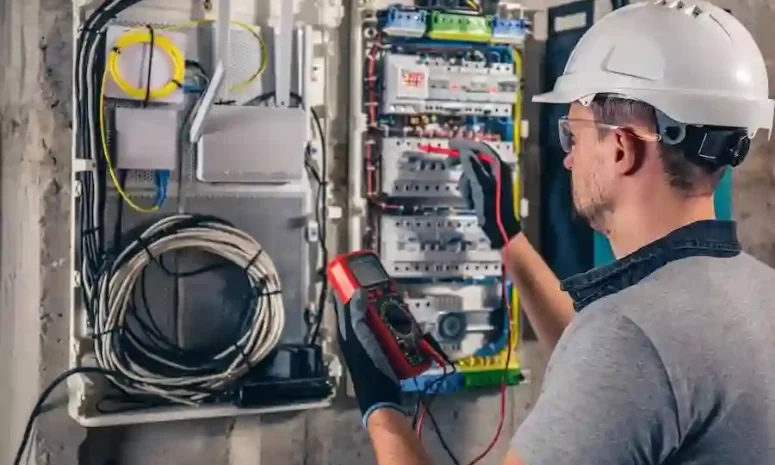
Electrical wiring might seem like a complex task that should be left to the professionals. Still, with the right knowledge and precautions, it’s possible for enthusiastic homeowners to tackle some electrical projects on their own.
So whether you’re looking to replace a faulty light switch or install a new outlet, understanding electrical wiring basics is essential for a safe and successful DIY endeavour.
Here are some pointers about the basics of electrical wiring so that DIY enthusiasts may get down to business without risking too much.
The Electrical Wiring Process
Before you get to business, you should know that what you are undertaking is anything but easy. Electricians are not licensed simply because it looks fancier. They need to understand their work, as it has serious implementations.
A faulty wiring can cause fatal electrical shocks, appliance damage and even electrical fires. Thus any DIY work should be handled with utmost seriousness and without cutting any corners. If you have no electrical work knowledge, it’s best to start with something small to see how electrical grids work on a smaller scale.
Also, if you have any doubt about whether you can do it on your own, it’s best to call a professional to handle it. Believe me. It’s much better to save your home and your life than your ego.
So, this being said, let’s dive right in.
The electrical wiring process involves a series of steps to safely and effectively connect electrical devices, ensure a proper power supply, and maintain safety throughout the project.
Electrical Power Service
Before beginning any electrical work, it’s essential to disconnect the electrical switch and the main service panel to ensure your safety. This means turning off the power supply to the area you’ll be working on.
By cutting off the power, you eliminate the risk of electrical shock and create a safe environment to proceed with your project.
Also, make sure to leave a note that you are working on the electrical grid. Otherwise, another tenant, a life partner or someone else can switch the electricity back “on,” and you will find out how it feels to be a bulb in a very unpleasant way.
Forgetting to inform other people living in the same home as you could be life-threatening, so make sure to leave a note and explicitly state you are working on the circuit so that no one would touch the breakers.
Disconnect the Electrical Switch
If you plan to replace a light switch or any other electrical device, the first step is to turn off the power supply to that specific switch. You can accomplish this by flipping the switch to the “off” position.
However, for added caution, it’s also recommended to turn off the circuit breaker that controls that switch. This double safety measure ensures no power flows to the switch and reduces the risk of accidents.
Moreover, it’s a good idea to triple-check with a multimeter whether the circuit was truly switched off.
Main Service Panel
The main service panel, often located in the basement or utility room, is the central hub of your home’s electrical system. It contains the circuit breakers that control electricity distribution throughout your house.
When you need to turn off the power to a particular area or carry out electrical work that involves the entire house, you must locate the main service panel and switch off the corresponding circuit breaker.
Labelling each breaker clearly is essential to make it easier to identify and control the power supply when needed. If you haven’t marked the breakers yourself, don’t overtrust them. For your safety, it’s better to check if the area you will be working on is cut off.
Installing a main service panel is a highly complex task, and we urge you not to do it on your own if you are not a licensed electrician.
Even if you decide to ignore our advice, you won’t be able to legally install such a panel, as you need a permit, which is given only to licensed professionals. So, installing a main service panel is not a DIY project by any means.
Circuit Breaker
They are designed to prevent your electrical system from overloading, which can cause fires and other hazards. Each circuit in your house is connected to a dedicated circuit breaker.
If the current exceeds the breaker’s capacity, it automatically trips. Thus the power supply is cut off to that circuit.
When working on electrical wiring projects, locating the correct circuit breaker and turning it off before starting any repairs or installations is crucial. This ensures that the circuit is de-energized, preventing potential accidents.
Just like with the main service panel, circuit breakers are too complicated to make them DIY.
Moreover, their function of preventing deadly electrical shocks, electrical fires and severe damage to your appliances is more than enough reason to leave this hard part to a professional, licensed electrician.
Devices
Electrical devices such as outlets, switches, and fixtures are integral components of the electrical wiring system.
When replacing or installing these devices, choosing ones suitable for the UK’s electrical system is important. Follow the manufacturer’s instructions carefully and adhere to recommended safety guidelines.
It’s also crucial to match the device’s voltage and amperage ratings with the circuit it will be connected to. If you’re uncertain about any aspect of the installation, it’s always advisable to consult an electrician or seek advice from a reputable source.
Electrical Wiring
The process of connecting the wires is a critical aspect of electrical wiring. In the UK, a specific colour coding system is followed:
- The live wire is typically brown.
- The neutral wire is blue.
- The earth wire is green and yellow.
It’s good to know that in older installations, you may find red (live), black (neutral) and green (earth) wires, as the new colour coding went into effect after 2004.
It’s essential to use appropriate connectors, such as wire nuts or terminal blocks, to ensure secure and reliable connections.
In addition, proper insulation of the wires is essential to prevent accidental contact and reduce the risk of electrical shock or fire hazards. Taking the time to route and secure the wiring carefully also helps maintain an organised and tidy electrical system.
Now that you know the basics of electrical circuits, it’s time to get to your first DIY project.
Tips for Electrical Work at Home
While taking on electrical projects at home can be fulfilling, it’s important to keep in mind a few tips to ensure safety and success:
- Always turn off the power before starting any work.
- Use insulated tools specifically designed for electrical work to reduce the risk of electric shock.
- Do not overload circuits, and avoid using extension cords as permanent solutions. Regularly inspect your electrical system for any signs of wear, damage, or loose connections.
- Stay informed about local building codes and regulations to ensure compliance with safety standards.
When to Call an Electrician?
Knowing when to call a professional electrician is crucial to prevent any accidents, ensure compliance with regulations, reduce your carbon footprint, and guarantee the longevity of your electrical system. While you can handle basic tasks like replacing a light switch, it’s best to leave it to the experts if you encounter complex issues or need to undertake extensive wiring projects.
Moreover, suppose you experience frequent circuit breaker trips, notice burning smells or sparking outlets, or have concerns about the safety of your electrical system. In that case, it’s advisable to call a licensed electrician to evaluate and address the problem.
If you are a serious DIY enthusiast, you know that safety comes first, especially when you are dealing with dangerous things like electricity. So while taking on projects and learning from experience is fun, it’s best to leave the serious work to licensed professionals.




